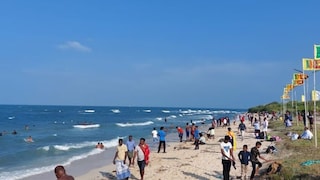Curated By: News Desk
Edited By: Shilpy Bisht
News18.com
Last Updated: March 31, 2024, 13:11 IST
New Delhi, India
In 1974, the Indian government handed over the island to Sri Lanka in an act of bilateral largesse. (News18 Tamil File Photo)
Prime Minister Narendra Modi on Sunday lashed out at the Congress over the controversial Katchatheevu island that was handed over to Sri Lanka by former Prime Minister Indira Gandhi in 1974. The debate around the Katchatheevu Island is currently hotting up in the Tamil Nadu politics and beyond ahead of the Lok Sabha Election.
PM Modi posted on social media site X about how the Congress “callously” gave away the Katchatheevu island to Sri Lanka, which “angered every Indian and reaffirmed in people’s minds – we cannot ever trust Congress”. He cited a report by The Times of India that documents why the Congress made that decision.
The report mentions Tamil Nadu BJP chief K Annamalai, who through an RTI application, obtained documents that revealed how Sri Lanka made up for its lack of size with “tenacious pursuit of 1.9 square km of land about 20 km from Indian shore based on claims which New Delhi contested for decades”.
After Independence, Sri Lanka pressed it claims, and did not allow the Indian Navy to conduct exercises on the island without its permission.
The then prime minister, Pandit Jawaharlal Nehru, dismissed the issue as inconsequential. “I attach no importance to all to this little island and I would have no hesitation in giving up our claims to it, ” Nehru wrote on May 10, 1961, Nehru was quoted by Times of India as saying.
Nehrus’ minute was prepared by Commonwealth Secretary YD Gundevia, which the Ministry of External Affairs (MEA) shared as “backgrounder” with the informal Consultative Committee of Parliament in 1968, as mentioned in the Times of India report.
The backgrounder reveals India’s “indecision” over pursuing the island, and gave up its claim in 1974. “No clear conclusion can be drawn as to the strength of either India’s or Ceylon’s (Sri Lanka) claim to sovereignty,” the MEA had said.
This decision came despite then Attorney General of India, MC Setalvad, stating in 1960 that India had a stronger claim over the island formed by the volcanic eruption in a clear reference to the Zamindari rights given by the East India Company to Raja of Ramnad over the islet and fishery and other resources around it.
The Raja enjoyed rights in Katchatheevu from 875 to 1948 which later got vested in the State of Madras after the abolition of the Zamindari system.
The documents also showed how then MEA’s joint secretary K Krishna Rao was not sure about the island, and concluded that India has a “good legal case which could be leveraged for securing fishing rights”.
In 1968, the Opposition attacked the Indira Gandhi government for speaking with the Sri Lankan Prime Minister Dudley Senanayake who showed the island in their territory on the maps.
The Opposition discussed the issue in Parliament amidst the suspicion of a deal being negotiated between Indira Gandhi and Senanayake.
The Congress dismissed the allegations about the deal, and clarified that the island was signed away as it was a dispute site and “India’s claim had to be balanced” with the need for “good bilateral ties”.
In 1973, foreign secretary-level talks were held in Colombo about the dispute island. A year later, the decision to relinquish India’s claim was conveyed to then Tamil Nadu chief minister M Karunanidhi in June by foreign secretary Kewal Singh.
The foreign secretary stressed that Sri Lanka had taken a “very strong determined position” on the basis of “records” showing the island was part of the kingdom of Jaffnapatnam, Dutch and British maps.
He asserted that Sri Lanka had asserted its sovereignty since 1925 without protests from India, and cited a second opinion of 1970 by then attorney general that “the sovereignty over Katchatheevu was and is with Ceylon and not with India”, as quoted by The Times of India.
In 1974, the Indian government handed over the island to Sri Lanka in an act of bilateral largesse.
Katchatheevu is an uninhabited off-shore island in the Palk Strait. It was formed due to volcanic eruptions in the 14th century. The 285-acre land was jointly administered by India and Sri Lanka during British rule.
In the early medieval period, the island was controlled by the Jaffna kingdom of Sri Lanka. In the 17th century, control passed to the Ramnad zamindari based out of Ramanathapuram, about 55 km northwest of Rameswaram.
In 1921, both Sri Lanka and India claimed the piece of land for fishing and the dispute remained unsettled. After India’s Independence, the country initiated to resolve the pre-independence territory dispute between Ceylon and the British.
St Anthony’s church — an early 20th century Catholic shrine — is the only structure on the island. Christian priests from both India and Sri Lanka conduct a service, where devotees from both the countries make the pilgrimage during an annual festival. Last year, 2,500 Indians visited Katchatheevu from Rameswaram for the festival.
